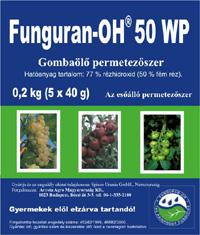Funguran OH 50 WP 10x20g
Authorised for organic production. Active ingredient: 77% copper hydroxide (50% metallic copper) Action Preventive contact bactericide and fungicide. On contact with the spray, spores and bacteria take up copper, which prevents germination and cell division. Copper disrupts the metabolism of pathogenic pathogens by inhibiting the reaction of man...
Long description
Shipping
block
Megszűnt termék, többé már nem lesz kapható
Authorised for organic production. Active ingredient: 77% copper hydroxide (50% metallic copper) Action Preventive contact bactericide and fungicide. On contact with the spray, spores and bacteria take up copper, which prevents germination and cell division. Copper disrupts the metabolism of pathogenic pathogens by inhibiting the reaction of many enzymes, competing with other metals in intracellular chelation and inactivating the formation of cell membrane proteins. Funguran-OH can also be used as a bactericidal and fungicidal agent. Fungicides are effective against fungi such as Alternaria, Plasmopara, Peronospora, Venturia, Taphrina, Monilia, Stigmina, Gnomonia, Cercospora, Phytophthora, Nectria, Mycosphearella, Colletotrichum, Hemileia, etc. Effective against bacteria Erwinia, Pseudomonas spp., Xanthomonas spp. etc. In potatoes, treatments should be started preventively based on the forecast and repeated as necessary every 8-12 days depending on the development of the infection. In sugar beet, control of foliar diseases other than powdery mildew should be started as a preventive measure or at the latest at the time of first symptoms. Depending on the weather conditions and the development of the disease situation, it may be advisable to repeat the treatment every 7 to 10 days. The product is recommended for use in apple crops as a wash spray in spring and autumn against bacterial and fungal diseases (scab, moniliaceae, twig dieback, etc.). Controls against fire blight can be carried out as a preventive measure, from bud break until the end of green bud stage, at 2-3 times, at a frequency of at least 7-10 days, with high application rates. After waxing of the crop, the product can be re-applied for final permeation, taking into account the copper sensitivity or risk of scorch. In nursery nursery stock nurseries and nursery stock nurseries, control of needle dieback should be carried out every 14 days in the period prior to infection with 300-400 l/ha of water, 2-3 times. In stone fruit: control of peach scab disease should be completed by spraying with a wash at the latest at bud break to avoid the risk of scorch. Treatments against bacterial and fungal twig blight should be carried out in the autumn, at the beginning of leaf fall. In plums, sour cherries and cherries, spraying against leaf blight and moniliasis can be carried out continuously during the growing season, according to the development of the infection. In berries, treatments against cane and leaf diseases are recommended as a wash at the beginning of the growing season and after harvesting. In shell fruits, treatments should be started after the appearance of diseases and repeated every 14 days depending on the severity of the infection. In grapes, treatments against grapevine peronospora should be started preventively, based on the forecast, around the 20-25 cm shoot stage and continued every 7-14 days depending on the development of the infection. Residual treatments after cluster closure are also beneficial for effective control of grey mould. In vegetable crops: peppers, tomatoes, cucurbits, beans, peas, onions, treatments against bacterial and fungal diseases should be started preventively based on the forecast and repeated every 2-3 times every 10-14 days depending on the development of the infection. In periods of pest risk, 2-3 additional treatments against bacterial diseases in sweet pepper are necessary. When spraying onions and peas, the addition of a wetting agent is justified to increase the adhesion of the spray. Ideal conditions The rain resistance of Funguran-OH is unique among similar formulations. In crops where bacterial diseases can be a problem (beans, tomatoes, potatoes, etc.), bacteria can attack freely on a surface 'cleaned' with fungicides. Funguran-OH can also be used to complement the bactericidal action of the latest types of fungicides. When designing the treatments Authorised crops/damaging agents Culture: Nectric canker of apple, Colletotrihum disease of bean, Curtobacterial wilt of bean, Pseudomonas disease of bean, Xantomonas disease of bean, Bean rust, Ascohytaceous disease of pea, Pseudomonas disease of pea, Pea peronospora, Pea rust, Alternaria disease of potato, Phytophthora disease of potato, Blumerellosis of cherries and sour cherries, Mycospermellosis of cherries and sour cherries, Leaf spot disease of stone fruit, Cercosporosis of sugar beet, Phoma leaf spot of sugar beet, Erwinia amylovora, Onion peronospora, European powdery mildew of cumin and currants, Mycospherellosis of cumin and currant leaves, Cumin aphid, Didiomellosis of raspberries, Elzinoid disease of raspberries, Monilia, Alternaria blight of pepper, Phytophthora disease of pepper, Colletotrihum blight of pepper, Macrophomycosis of pepper, Pseudomonas disease of pepper, Pseudomonas berry rot of pepper, Rhizoctonous seedling blight of pepper, Xantomonas blight of pepper, Currant rust, Strawberry gnomonas disease, Strawberry mycospherellosis, Grape pseudopesticulosis, Grape peronospora, Taffrine leaf spot, Varroasis
| Weight: | 0.2 kg |
|---|---|
| Aviability: | 1-4 nap |
| Basic sales unit: | db |
| Culture: | Bio, Gyümölcs, Szőlő, Zöldség |
| Növényvédőszer forgalmazási kategória: | III. szabadforgalmú |
| Termék ismertető | T01006-2-Attachment-Organova-Termek_dokumentumok-Fungurantermism.pdf |
|---|
Login
Login or registration with a social account
Login
Login or registration with a social account
